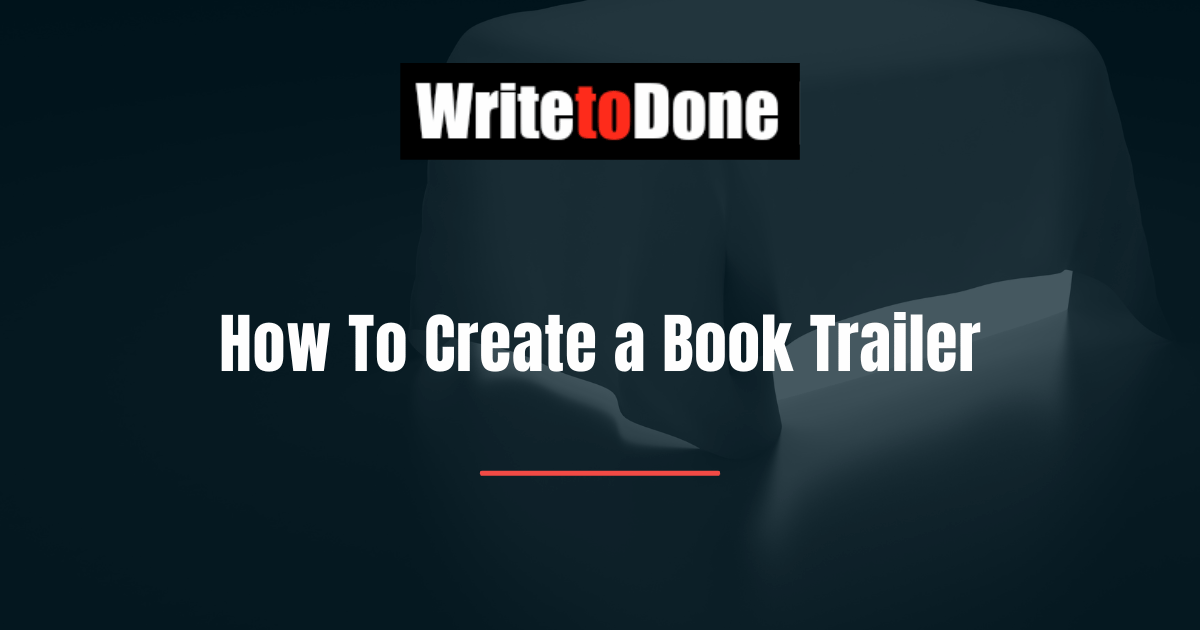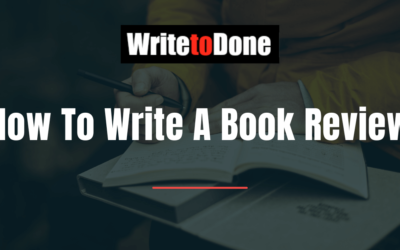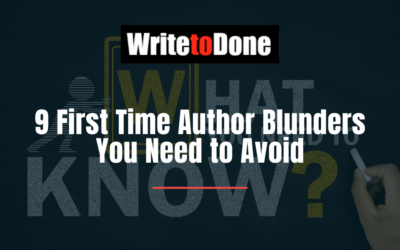Would You Like to Get Your Book Noticed?
But maybe you don’t have enough time.
Not enough time for your day job, your family and friends, and certainly not enough time to market a book.
Oh, did I mention not enough time to write? That too.
As you can imagine, the last thing I ever wanted to do was make a trailer for my book. Sure, I could record myself talking the book up — not a bad idea if I already had fans, but hardly my concept of compelling video. And if I didn’t want to watch it, why would anyone else who didn’t already know me?
Thinking about the time and money it would take to make a book trailer — or paying someone else to do it — made my stomach churn. Not to mention that I’ve never bought a book based on a trailer, or ever run across a trailer that didn’t bore me to distraction.
How to create a book trailer simply and cheaply
Let me go out on a limb here and say that most trailers are over-produced.
Why is this? The problem is an embarrassment of digital riches. It used to be that only major outfits could make movies. No more. Got an iDevice? You’re a producer.
It’s so easy to produce video that it’s intimidating. Most trailer-makers, including professionals, get carried away and try to do too much. When you throw in everything but the kitchen sink, the result looks cheesy.
The real trick is learning what to leave out.
But I didn’t realize this until I encountered Iris Has Free Time, a brilliant trailer that is so NOT boring I watched it twice again after I first saw it, just to see how it had been stitched together.
In The Creative Confidence Matrix, Mary Jaksch talks about how letting go of ideas and preoccupations will create beginner’s mind. That’s what happened to me when I watched Iris Has Free Time.
That 2-minute video helped me to re-frame the making of a trailer. I forgot it was impossible.
Suddenly, the difficulty was transformed — what had been a time-and-money-sucking beast now appeared as a creative puzzle to solve.
A trailer is an ad, a spell
Its purpose is to arouse your interest and seduce you to consider a purchase. A lot of trailers involve talking heads—fine if you already love the author. But many last several minutes. I ask you: do you want to spend that long watching a commercial?
The trailer for Iris Has Free Time was plainness itself: a string of still photographs of a young woman (in a tutu!) underscored with a modest piano tune. There was some barely noticeable written text. The sequence took place over a single day, and was utterly captivating.
How much did it cost? Could be the publisher spent a lot hiring professionals. Could be the author herself shot it on a lark with a friend.
Either way, when I saw it I thought: This is thrilling. It’s something I want to try.
Not because book marketers say a trailer is necessary. But because the thought of all that simplicity filled me with enthusiasm.
I couldn’t wait to see what I was going to leave out.
Arousing curiosity for an odd bird
My book Breathing for Two is an odd bird, and I didn’t think I could fully explain it in a trailer. But now I knew I didn’t have to (simplicity!). All I had to do was get people curious.
I wasn’t going to copy Iris, obviously. But I would go for the same clean lines. I liked that you didn’t even know Iris was a trailer until you saw the book’s cover at the end. That bit of structure I would keep.
Breathing for Two is about my day job, anesthesiology. It’s non-fiction, a short, poetic dissection of life at the head of an operating table, meant for the curious. People are intrigued when I tell them about the book. But what elements would best get them to ask for it? That’s what would go in the trailer.
Constraint forces creativity
As a filmmaker, I am an amateur. I have no special knowledge or equipment. But I do know something about simplicity—that it comes of limitation. And limitation, far from obstructing creativity, frees it.
Have you ever been to Portland, Maine?
After a devastating fire in 1866, residents rebuilt their town entirely in brick. You might think this would make a dreary, monotonous landscape, but native architects responded to the challenge with a riot of inventiveness that continues today. Portland remains a city full of whimsy and charm, and red brick.
Was there a way I could make my limitations work for me? What I lacked in chops and resources, could I make up for in resourcefulness?
That thought led to more specific questions: What tools did I already have? What elements (voice, music, photography, drawing, etc.) excited me? How could I combine them to make something that was good enough to show?
After a day or two spent pondering, I came up with three ingredients that appealed to me, and that I thought I could work with: a voice-over, music, and a few video shots of my hospital day.
I knew the narration already
The first paragraph of my book’s prologue is short and a bit mysterious. Why reinvent the wheel? I would employ those words and I would say them myself. I used a free program, Audacity, to record with my computer’s built-in mic and add some reverb. Cost: nothing.
Could I have used written text instead of voice? Sure. It’s easy to add text with video editors such as iMovie or Windows Movie Maker. Many trailers use text, but I believe it signifies an opportunity lost. Nothing is more resonant or persuasive than the human voice. And everybody has one.
Does your computer lack a built-in microphone? A zillion inexpensive smartphone apps record live voice and music, and send it to your desktop—Retro Recorder ($.99) and HT Professional Recorder ($9.99) are two that work well for the iPhone.
Don’t have an iPhone? I bet you have a friend who does.
The visuals
Still photos, paintings, sketches make great montage, and it’s easy to add image files into video editors. Just drag and drop. There are myriad low-cost or free sources of stock photos and art on the web such as Wikipedia Commons, Dreamstime, Photobucket, fotolia, Clker, morgueFile.
Better than stock photos and art, though, are photos and art you make yourself. Better because it’s you. Better because it’s free. Better because it’s unique.
You’re not a photographer? Ahem. Is it even possible to take a bad photograph with Instagram and the hundreds of other add-on photo apps?
You’re not an artist? Ditto ahem. Take a look at the cartoon art of James Thurber. Take a look at Lewis Carroll’s original manuscript artwork for Alice in Wonderland, rejected by his publisher in favor of the more “polished” drawings of a professional artist.
Lowering video expectations
Stills would have worked fine for my trailer, but I wanted motion. Why? Because I got fired up thinking about it, and I’d already thought of a sequence of shots.
I wanted video to match the narration’s tone: mysterious, almost dream-like. The look of an old, black and white film would suit. I found a plugin for Apple Final Cut Pro that would work. Cost? $200 for a video camera, $300 for Final Cut Pro, $1,000 for the plug-in.
Oops.
In 4 Ways to Hack into Your Mind, Ollin Morales argues that lowering your expectations leads to unexpected results. Could I come up with a less expensive solution using tools I had on hand?
On my iPhone, I have a video program called Super 8. It makes camera video shots look like an old, Super 8 movie, complete with glitches—and you can shoot in color, or black and white. Android phones have similar apps.
I arrived at work early one day and walked around the empty operating room, iPhone in hand. Problem solved.
Revised cost? $.99 for Super 8 — much better.
Listening for music
Voice by itself is often enough of a soundscape, but I thought a touch of background music would add color, if I didn’t overdo it.
Where would I get the music? As it happens, a few years ago I had noodled around with some loops in a friend’s Apple Logic program to create a tonal piece. It now seemed just right for the atmosphere I wanted.
Don’t have $200 for Apple Logic? Use a program like Garage Band (free with a new Mac; otherwise $14.99 in the Mac App Store) or Mixcraft, the Windows equivalent ($10 for a month’s use.) Not a music noodler? Check out the Free Music Archive.
Maybe you play an instrument? Or your friend does? Try recording on an iPhone with the $10 HT Professional Recorder app. Can you tell the difference between that and the sound produced in a million-dollar studio?
I can’t.
Editing your trailer
You need an editing program to put your elements together. Most everything you want can be found in Windows Movie Maker (free) on a PC, or iMovie on a Mac (free on a new machine, otherwise $14.99 in the Mac App Store). You can find fancier programs for less than $100—make sure to trial before you buy. No need to splurge on Apple Final Cut or Adobe Premier unless you plan to turn pro.
All editors are alike, more or less. The interface has three areas:
- A timeline at the bottom where your video and audio tracks go, and where it’s easy to rearrange segments or edit out what you don’t want
- A preview area where you can watch your movie, and
- An area where you keep elements you want to add in — sound files, images, video clips, etc.
Everything works by drag and drop.
I used the Pinnacle Studio editor app ($12.99) to put all the elements together on my iPad. It was up and running in half an hour.
I had three tracks: the video I’d emailed from my iPhone to my desktop and then synced to my iPad through iTunes. And two sound files (music and narration), similar iTunes transfers.
How to upload your trailer
When your trailer’s ready, open an account on a video service like YouTube or Vimeo. Many editing programs will upload to these directly, or you can export your trailer as a movie file and upload it manually — the sites provide instructions.
If you run into descriptions of technical terms such as codexes or compression, you can forget about them. Your trailer will be too small a file to worry about compressing.
Once your trailer is uploaded, link to it. Better, copy the embed code (click on “Share” — upper right corner of the trailer on Vimeo; underneath the trailer on YouTube). You can paste the code into any blog post, as below.
And the winner is . . .
Did my trailer adequately summarize my book? Not really, but that wasn’t its purpose (remember: lowered expectations). What I wanted is to make people curious. You be the judge.
Intrigued? Ask me about it.
The bottom line
Total out-of-pocket expense for my little experiment? $13.98.
Total time spent? I won’t kid you. I spent 4-5 hours a day for several days doing what I described above: 2 days figuring out what to do and researching how to do it, another 2 days on the narration and video, and 2 days editing and uploading. On the seventh day, I rested.
I didn’t work every day, so from start to finish it took a few weeks. But still, how did I find the time? I don’t know. I was fired up. I was a filmmaker! Other projects lost their luster and I put them on hold.
Of course, I’m not really a filmmaker. Neither am I a media techie. When I started, I had no idea what I was doing. What I had were my limitations. But that’s the point. If you use the tools you have, your limitations will parent your creativity.
I didn’t get carried away with all the snazzy things you can do in video editing programs. I decided in advance what elements I would use, and how I’d use them. I played to my strengths. Your strengths are different. And your trailer will play to those.
“But I’m writing sci-fi on another planet, or a fantasy romance in the middle ages!”
Okay — you probably can’t afford to shoot a large landscape action sequence with professional actors in costume. But why bother? You’re not making a movie. You don’t need to tell the whole story.
Go with your theme. Go with one detail. Why did you write your book? What do you love about your main character? Talk about that. Show it in a single image.
On my wall I’ve taped an old Sister Coreta postcard with the caption: Turn your avoid dance into a void dance. I always liked the words, but never really got it until I attacked the trailer problem.
Maybe, like me, you’ve put a trailer or some other project on hold because it seemed too agonizing to contemplate? Maybe it’s time to let go of your ideas and preconceptions about it and become a beginner. You might find, as I did, that your limitations will ignite you and lead directly to your creative source.
If Iris Has Free Time isn’t your cup of tea, here’s a stack of fantastic trailers. Here’s a collection of the best and worst. Here are some made by elementary school kids. Take a look to see if anything grabs you—maybe you can do it better, simpler, and for less money.
You might surprise yourself. I surprised myself. I love my trailer, and I love talking about it (can you tell?). Who knows — it might even sell a few books!
Ready to give it a whirl, or do you still have doubts? Tell us about them. Maybe you have some favorite trailers? Share them in the comments, please!


















